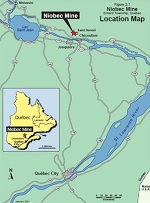
The Niobec underground niobium mine is located twenty five kilometres northwest of Ville de Saguenay (Chicoutimi), within the limits of the municipality of Saint-Honoré, Québec. This area is approximately 200 kilometres north of Québec City. The Niobec property covers a total area of approximately 1,735 hectares, comprising two mining leases and also includes 43 claims totalling 1,605.6 hectares. The Niobec Mine is readily accessible by existing paved roads and benefits from available water supply and hydroelectric generated power supply from the regional power grid. The Niobec mine is surrounded by a mixture of forest and farms.
Ville de Saguenay has a population of about 150,000. The city is serviced several times a day by regional airlines from Montreal. It is about a two and a half hour drive to Québec City and five hours to Montreal. Schools, hospitals, government services, suppliers and manpower are all available in Ville de Saguenay.
History
The Niobec mine is North America's only source of pyrochlore, the primary niobium ore and one of only three major producers of niobium in the world. The Niobec deposit has an excellent history of mineral reserve renewal over 30 years of operation. It is currently producing approximately 7 to 8% of world consumption.
The Niobec deposit was discovered in 1967. Commercial production of niobium pentoxide concentrates began in 1976. For the first 18 years of operation, production was shipped as concentrates to firms in Europe, India, Japan and the US and sold to intermediate processors for conversion into ferroniobium. Since1994 ferroniobium has been produced at the mine site and is directly marketed to the steel industry. Ferroniobium is used by steel and specialty metals manufacturers as an alloy to enhance the physical, mechanical, chemical and thermal properties of their products. Steels containing niobium are classified as High Strength Low Alloy (HSLA) steels and used in the pipeline, construction, aeronautical and automotive industries.
An expansion program in 2005 increased the mine's capacity by 20% and by a further 10% in 2006. Daily milling capacity was increased from 4,200 tonnes to 4,800 tonnes in the second half of 2006.
In 2007, as part of a $20.3 million capital program, a new hoist was installed and the headframe extended in preparation for a shaft deepening program to be carried out in 2008. The shaft was deepened from 550 metres to 817 metres.
In June 2008, the Company announced the positive results of a feasibility study for construction of a paste backfill system. A technical report was prepared showing that the paste backfill system would enable near complete extraction of the ore body at lower levels of the mine by using mill tailings mixed with binding material, significantly reducing the need to leave behind natural ore pillars.
In February 2009, the Company announced that proven and probable reserves as at December 31, 2008 increased 36% to 137,800 tonnes of contained Nb2O5, based on the use of paste backfill.
By Q3 2010, both the paste backfill project and mill expansion were completed.
Milestones
1967 Niobec mine discovered by SOQUEM Inc.
1976 Commercial production of niobium pentoxide concentrates
1986 Cambior Inc. acquires SOQUEM's 50% interest in Niobec
1994 Commercial production of ferroniobium
2001 Mazarin Inc. acquires Teck Corporation's 50% interest in Niobec
2003 Sequoia Minerals Inc. is created after the reorganisation of Mazarin
2004 Cambior acquires remaining 50% interest in Niobec from Sequoia Minerals
2006 IAMGOLD acquires the Niobec mine through the Cambior transaction
2008 Feasibility Study & Technical Report identifies significant increase in Niobec mine life
2010 Paste backfill plant and 24% mill expansion project completed
Geology
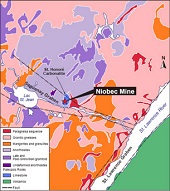
The Niobec deposit lies within the southern portion of the Saint-Honoré carbonatite, within the Grenville structural province of the Canadian Shield (Stockwell, 1964). Dimroth et al. (1981) subdivides the Grenville province into three distinct litho-structural units; a gneiss complex, the anorthosite and charnockite-mangerite batholiths and the calc-alkaline intrusions.
The development of the early Paleozoic St-Lawrence River rift system was associated with extensive alkaline igneous activity (Kumarapeli and Saull, 1966), including the emplacement of the Saint-Honoré carbonatite (650 Ma; Vallée and Dubuc, 1970).
A carbonatite is an igneous rock comprising at least fifty percent carbonate minerals. Occurrences on a global scale are sparse and widely distributed. Dominant carbonate minerals, in order of decreasing abundance, include calcite, dolomite, ankerite, and rarely siderite and magnesite.
The St-Honoré alkaline complex is almost completely covered by Trenton limestone of Palaeozoic age and is elliptical in plan view, with a major axial length of approximately four kilometres. It consists of a series of crescentic lenses of carbonatite with compositions becoming younger progressively inwards from calcitite through dolomitite to ferrocarbonatite. Rocks immediately surrounding the complex are composed of magnetite diorite as well as hypersthene syenite.
Mineralization
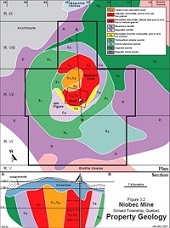
Niobium-bearing minerals of bi-pyramidal form are disseminated throughout the carbonatite. The economic mineralization is comprised of ferrian and sodic pyrochlore, generally in association with geological units rich in magnetite, biotite and apatite. The niobium-bearing minerals dispersed in the rock are fine-grained (0.2 to 0.8 mm in diameter) and rarely visible to the naked eye such that diamond drilling is the only way to evaluate the economic content of mineralized zones.
Mineralized envelopes vary between 45 and 180 meters in width (north-south direction) while their length can reach almost 750 meters. The zones have a known vertical extent of approximately 750 meters, although they remain open at depth. The deepest completed drill holes are mineralized at grades equivalent to those of current ore production. Dips are generally vertical or steeply dipping (>70°) to the northwest or northeast.
Average grades of the large mineralized envelopes are between 0.44 and 0.51% Nb2O5. The majority of the mineral reserves and the measured and indicated resources are located in the four first mining blocks between 90 and 560 meters in depth. The bulk of the mineral resources classified as inferred are exclusively found in mining blocks 4, 5 and 6, between depths ranging from 560 to 730 meters. Mine operations are concentrated between depths of 100 to 440 meters, currently operating simultaneously on three mining blocks.
Mining
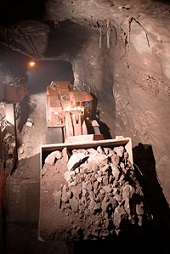
The Niobec mine facilities include a headframe, a niobium pentoxide (Nb2O5) concentrator, a concentrate-to-ferroniobium converter and ancillary surface installations.
Historically open stoping without backfill has been the only mining method used at Niobec. Stopes are planned and designed based on geological information obtained from diamond drilling. The average size of the stopes is about 200 ft in length, 80 ft in width and 300 ft in height, corresponding to the vertical distance between development and production levels. An 80 ft pillar is then left between the stopes.
To extract the ore, the stopes are drilled with vertical 6.5 inch diameter holes, loaded with explosives and detonated. The ore that is broken by the blasting falls to the lowest level of the stopes, where it is gathered and transported using 6.5 cubic-yard loaders and 26 tonne trucks. The ore is then crushed underground to a diameter of 3.5 inches before being hoisted to the surface through the shaft and transferred to the concentration plant.
The continuation of open stoping without backfill following the shift to deeper mining would have greatly restricted the proportion of ore that could be mined versus the material that would have been left behind. The use of paste backfill allows a nearly complete extraction of ore grade material and has created an automatic and important increase in reportable reserves and resources from within the same ore volumes.
The potential to realise additional tonnage from the current mining levels through the use of paste backfill is also being investigated.
Concentrator
The Niobec processing facilities use conventional crushing, rod and ball mill grinding, followed by a number of processing steps to obtain pyrochlore concentrate.
The recently completed expansion project for the concentrator will increase the plant throughput capacity by 24% from its current level to 2.2 Mtpa of ore. Each tonne of ore yields an average of 3.7 kg of niobium pentoxide.
The product is a pyrochlore concentrate with 58% niobium pentoxide (Nb2O5). Processing in the plant includes: crushing, grinding, sorting, desliming, magnetic separation, three types of flotation, leaching, two filtering steps and drying of the concentrate. Fifteen different chemicals are used in processing with daily consumption of these chemicals reaching approximately 35,000 kg for the production of 30,000 kg of concentrate. Water plays an important role in the process with nearly 6,700 gallons/minute being used. This water is recycled at a rate of 85%.
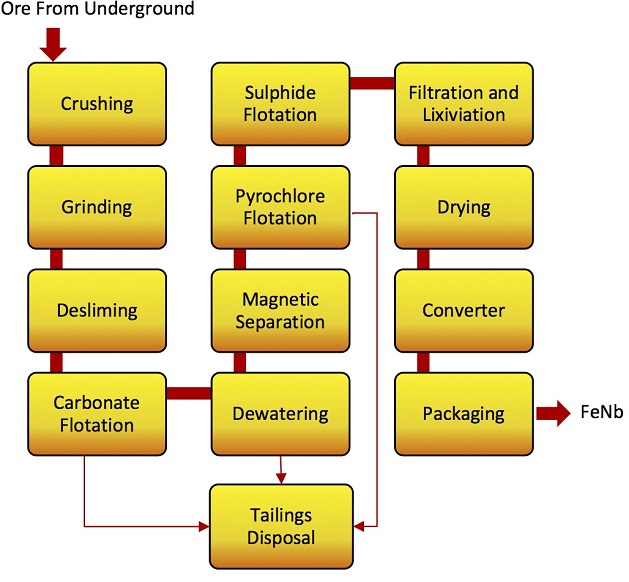 Converter
Converter
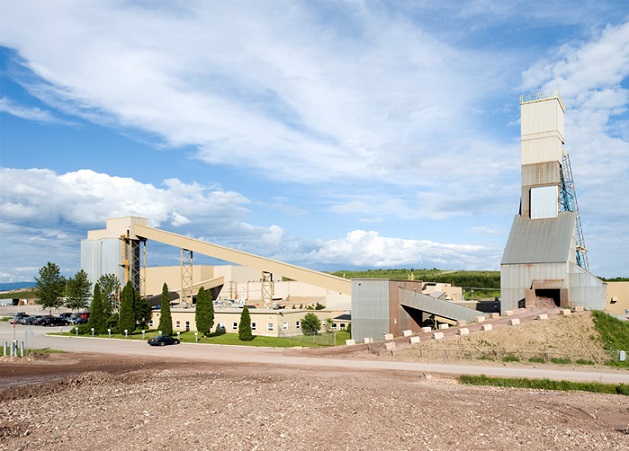
The conversion of niobium concentrate into ferroniobium (FeNb) is completed onsite using an aluminothermic reaction. The process involves a reaction between niobium oxide, metallic aluminum and iron oxide to produce aluminum oxide (slag), and metallic ferroniobium.
Conversion at Niobec is a batch process. A typical batch comprises of 3-½ tonnes of Nb2O5 concentrate, one tonne of aluminum, 675 kg of iron oxide and 675 kg of other products for a total of nearly six tonnes. This combination produces a powerful exothermic chemical reaction that generates enough heat to raise the temperature above 2,200°C, melting the entire load in less than ten minutes. The reaction produces 2,100 kg of ferroniobium, which is crushed and packaged to client specifications and 3,750 kg of slags that are stored in a sealed underground chamber.
Video

 The Niobec underground niobium mine is located twenty five kilometres northwest of Ville de Saguenay (Chicoutimi), within the limits of the municipality of Saint-Honoré, Québec. This area is approximately 200 kilometres north of Québec City. The Niobec property covers a total area of approximately 1,735 hectares, comprising two mining leases and also includes 43 claims totalling 1,605.6 hectares. The Niobec Mine is readily accessible by existing paved roads and benefits from available water supply and hydroelectric generated power supply from the regional power grid. The Niobec mine is surrounded by a mixture of forest and farms.
The Niobec underground niobium mine is located twenty five kilometres northwest of Ville de Saguenay (Chicoutimi), within the limits of the municipality of Saint-Honoré, Québec. This area is approximately 200 kilometres north of Québec City. The Niobec property covers a total area of approximately 1,735 hectares, comprising two mining leases and also includes 43 claims totalling 1,605.6 hectares. The Niobec Mine is readily accessible by existing paved roads and benefits from available water supply and hydroelectric generated power supply from the regional power grid. The Niobec mine is surrounded by a mixture of forest and farms. The Niobec deposit lies within the southern portion of the Saint-Honoré carbonatite, within the Grenville structural province of the Canadian Shield (Stockwell, 1964). Dimroth et al. (1981) subdivides the Grenville province into three distinct litho-structural units; a gneiss complex, the anorthosite and charnockite-mangerite batholiths and the calc-alkaline intrusions.
The Niobec deposit lies within the southern portion of the Saint-Honoré carbonatite, within the Grenville structural province of the Canadian Shield (Stockwell, 1964). Dimroth et al. (1981) subdivides the Grenville province into three distinct litho-structural units; a gneiss complex, the anorthosite and charnockite-mangerite batholiths and the calc-alkaline intrusions.
 The Niobec mine facilities include a headframe, a niobium pentoxide (Nb2O5) concentrator, a concentrate-to-ferroniobium converter and ancillary surface installations.
The Niobec mine facilities include a headframe, a niobium pentoxide (Nb2O5) concentrator, a concentrate-to-ferroniobium converter and ancillary surface installations.

